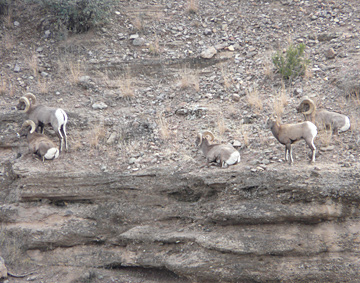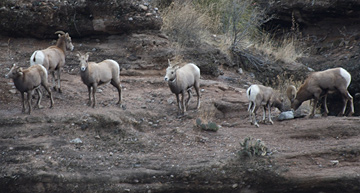About two weeks before Christmas, three Rocky Mountain Bighorn Sheep – two ewes and a huge ram with a magnificent set of double-curled horns – took up residence on the cliffs above Bear Creek directly in front of the Casitas. They stayed with us right through Christmas and left just before our big winter storm of December 30th, providing a real holiday treat for our guests. A few days after New Year’s, we noticed that the two ewes were back on the cliffs, absent the ram. And, as of this post, they are still with us!

These sheep are part of a larger herd of approximately 30 individuals that roam wild over some 25 square miles of the lower Bear Creek drainage basin, of which the Casita lands are a part. Groups of these sheep, ranging from just 2 or 3 to as many as 15 or 20, have been regular visitors to the Casitas since we opened 12 years ago. The 120-foot vertical cliffs of Gila Conglomerate rising up from Bear Creek to the steep, grass- and juniper-covered slopes of North and South Peak directly across from the Casitas provide classic habitat for the Bighorn: safety from predators, dependable water below, and abundant grazing above. Their schedule is totally unpredictable. Sometimes they stay a week or more, other times just a night or two. However, whenever they come, our guests are always treated to a rare and highly entertaining slice of nature.
It’s always a wonderful surprise of nature when the sheep appear. Sometimes it is the sound of a dislodged rock falling from the cliff that catches your attention. Or maybe you are just out walking the trails in front of the Casitas and a patch of white against the reddish-tan cliff face catches your eye. Looking closer, you find yourself smiling as the white patch gradually reveals itself to be the snowy-white rump of a sheep’s otherwise reddish-tan body, perfectly camouflaged against the rocks. The sheep are very well accustomed to the presence of the Casitas and our guests and show only mild curiosity for the activity of the humans and our two Springer Spaniels, Chloe and Bower. That is, as long as we stay on our side of the creek! So when the sheep do appear, we simply ask our guests to keep to the trails away from the cliff and not get too close to the sheep. Using the Casitas’ spotting scopes, the sheep can provide hours of entertainment, especially in late spring or early summer when the young lambs are racing up and down the ledges on the vertical cliffs in endless gravity-defying acrobatics! On rare occasions, in the Fall and early Winter, just prior to and during the breeding season, we or our guests may hear what sounds like rifle shots down in the creek near the cliffs. However, upon investigation what is found is only two or three large rams squaring off and butting heads.

Rocky Mountain Bighorn Sheep tend to live and travel in groups. The largest groups consist mostly of ewes, young adults of both sexes, and lambs. Mature rams tend to be more solitary, living alone or in small groups, except during the late fall and early winter when they join up with the ewe groups to breed. Lambs are born six months later, during late Spring or early Summer. They eat all kinds of plants, depending on the time of the year, showing a preference for weeds, wildflowers and grasses, but will also forage on leaves and stems of woody plants. Other than humans, predators of mature bighorns are primarily mountain lion (Puma concolor). Young adults and lambs are also prey for coyotes (Canis latrans), bobcats (Lynx rufus), and the golden eagle (Aquila chrysaetos). All of these predators are found on the Casita lands, and indeed over the years we have come across a couple of sheep kills, most probably due to mountain lion.
Historically, Rocky Mountain Bighorn Sheep (Ovis canadensis canadensis) were probably never widespread in New Mexico, with recorded evidence documenting only four populations in the northern half of the State*. By the early 1900s, however, they were all gone, having been eliminated primarily by intensive hunting and through competition from, and more importantly through, the introduction of diseases from an expanding domestic livestock population. Here in the Gila area, the Rocky Mountain Bighorn are not known to have been native, but instead were most probably a subspecies known as the Desert Bighorn Sheep (Ovis canadensis nelsoni), a somewhat smaller relative of its northern cousin that is well adapted to the heat, cold and lack of water of the desert Southwest. However, for the same reasons that caused the demise of their relatives to the north, by the mid-1800s the native Desert Bighorn of this area were also gone.
Efforts to reintroduce Rocky Mountain Bighorn Sheep into New Mexico began in 1932. It was not until 1940 that a successful population was established in the Sandia Mountains in the northern part of the State.* Then, in 1964 and 1965, 18 Rocky Mountain Bighorn Sheep were brought from the Sandia Mountains and returned to the wild in the Sheridan Ridge area of the Mogollon Mountains near Glenwood, about 20 miles northwest of the Casitas. Apparently they didn’t like this area, as only a year later the herd had moved south across US Highway 180 to take up residence in the San Francisco River drainage, where they remain today with a population of some 75–90 individuals as of 2004.
Closer to the Casitas, and also as a part of the 1964 reintroduction program, 10 Rocky Mountain Bighorn Sheep were brought from Banff National Park in Canada and returned to the wild in the Turkey Creek area of the Gila Wilderness, about 10 miles north of the Casitas.* Five more Rocky Mountain Bighorn Sheep from the Pecos Wilderness in northern New Mexico were later added to this herd in 1998, to help stabilize the population. Today, the Turkey Creek herd is found in 2 separate, but probably interbreeding, populations, one on Watson Mountain, 8 miles north of the Casitas in the Gila Wilderness, and the other ranging over a 25-square-mile area along Bear Creek, centering in the Hell’s Half Acre area about 7 miles southeast of Watson Mountain and 4 miles east of the Casitas. In 2004, the Turkey Creek herd was estimated at 40 individuals. The maximum number we have seen here at the Casitas at one time was 22 individuals about 6 years ago, but large group visits numbering as many as 15 or so have been seen every year, including last summer.
Reference:
2005, Long Range Plan for the Management of Rocky Mountain Bighorn Sheep in New Mexico 2005-2014, WildlifeManagement Division, New Mexico Department of Game and Fish, Santa Fe, New Mexico, written by Eric Rominger and Elise Goldstein
For those readers interested in learning more about Rocky Mountain Bighorn Sheep in New Mexico, the above reference is available on the Internet as a PDF file at: www.azgfd.gov/pdfs/w_c/bhsheep/LongRangeBighornPlan2005.pdf


